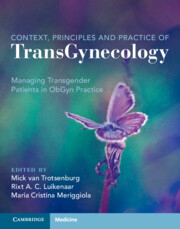Book contents
- Context, Principles, and Practice of Transgynecology
- Context, Principles, and Practice of Transgynecology
- Copyright page
- Dedication
- Contents
- Foreword
- Preface
- Contributors
- Abbreviations
- Section A Contextual Transgynecology
- Section B Practicing Transgynecology
- Section C Gynecological Surgery for Transgender Males
- Section D Sexuality and Contraception
- Section E Fertility and Reproduction
- Section F Impact of Gender-affirming Hormonal Therapy on Genital Organs
- Chapter 31 Changes to the Uterus from Supraphysiological Androgens
- Chapter 32 The Ovaries under Supraphysiological Androgen Exposure
- Chapter 33 The Vaginal and Neovaginal Microbiome under Androgen or Estrogen Exposure Respectively
- Section G Screening and Prophylaxis
- Transgynecology Index
- References
Chapter 33 - The Vaginal and Neovaginal Microbiome under Androgen or Estrogen Exposure Respectively
from Section F - Impact of Gender-affirming Hormonal Therapy on Genital Organs
Published online by Cambridge University Press: 22 December 2022
- Context, Principles, and Practice of Transgynecology
- Context, Principles, and Practice of Transgynecology
- Copyright page
- Dedication
- Contents
- Foreword
- Preface
- Contributors
- Abbreviations
- Section A Contextual Transgynecology
- Section B Practicing Transgynecology
- Section C Gynecological Surgery for Transgender Males
- Section D Sexuality and Contraception
- Section E Fertility and Reproduction
- Section F Impact of Gender-affirming Hormonal Therapy on Genital Organs
- Chapter 31 Changes to the Uterus from Supraphysiological Androgens
- Chapter 32 The Ovaries under Supraphysiological Androgen Exposure
- Chapter 33 The Vaginal and Neovaginal Microbiome under Androgen or Estrogen Exposure Respectively
- Section G Screening and Prophylaxis
- Transgynecology Index
- References
Summary
A particularly important, yet largely underappreciated, aspect of transgender health relates to the creation of novel microbiome niches with gender-confirmation surgery. In transwomen specifically, gender-confirming surgery may involve the creation of a vault through vaginoplasty [1], open to microbial colonization. In ciswomen, it is rather well established that the vaginal microbiome tends to be dominated by niche-specific Lactobacillus taxa, an ecology understood as central to human reproductive health [2,3]. Perturbations of this community ecology in turn are known to predispose to an array of adverse health conditions, including an overall increased acquisition risk of sexually transmitted infections (STIs). Apart from surgical interventions, transwomen as well as transmen will most often receive gender-affirming hormonal treatment, which may also affect the structure and function of the vaginal as well as of the neovaginal microbiome. In this chapter, we will review what is known of the neovaginal microbiome, as well as the effects of estrogen and androgen exposure on the vaginal and neovaginal microbiome, respectively.
- Type
- Chapter
- Information
- Context, Principles and Practice of TransGynecologyManaging Transgender Patients in ObGyn Practice, pp. 243 - 249Publisher: Cambridge University PressPrint publication year: 2022



